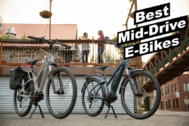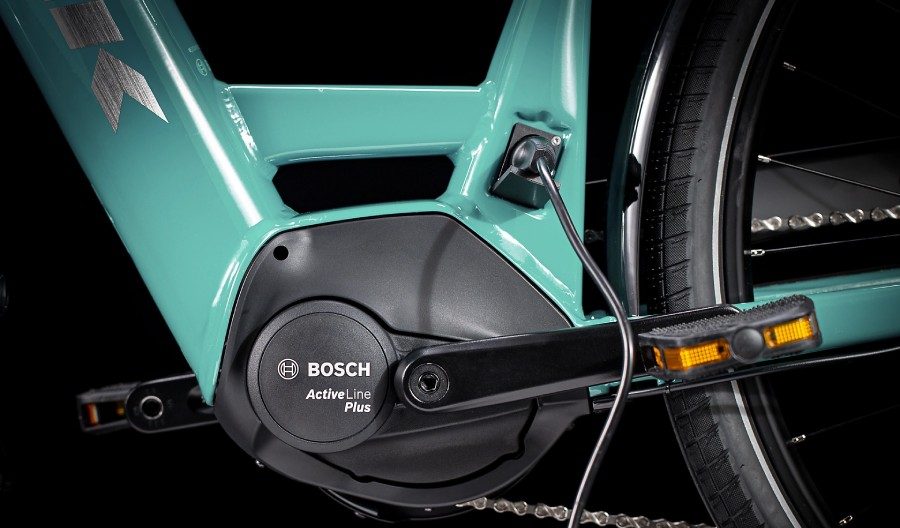
Image source: Trek Bikes
Many riders struggle to choose an e-bike because of the overwhelming variety of electric bike motors and other electrical component options.
By learning the basics of electric bike motors, you will be able to make smarter purchase decisions and understand how to get the most out of your e-bike.
This article will cover the different motor types, their ratings, how e-bike systems work, and highlight the top manufacturers. In addition, we will discuss the pros and cons of the various designs and how they compare to each other.
Electric Bike Motors Explained: How They Work
Both an electric bike hub motor and mid-drive electric bike motor convert electrical energy from the battery to mechanical energy (movement).
Inside modern brushless e-bike motors, there are two sets of electromagnets, one static and one moving. The fixed magnets with the coils attached—also called the stator—are energized in sequence, creating a magnetic field that spins the moving ones, also called the rotor.
- Related guide: What Is an eBike and How Does It Work?
Both mid and hub motors create torque to move a shaft. On hub motors, the rotor connects to the shaft, which drives the wheel axle, propelling the bike. Conversely, on mid-motor electric bikes, the stator connects to the shaft and drives the cranks.
Torque (Nm)
Torque is the measurement of rotational force measured in Newton-meters. This rotational force is what twists the motor shaft around.
Speed (rpm)
Motor speed refers to how fast the shaft rotates around its axis, measured in revolutions per minute.
Power (W)
Power is the measurement of how fast work is being done. In other words, a product of the twisting force and the rotational speed from the twisting force. A basic version of the formula for the power is; Power (W) = Torque (Nm) x Speed (rpm).
The rated power of a motor is the maximum amount of power, in Watts, it can provide under specified conditions. This number may indicate maximum sustained or peak power, which we will discuss later.
Throttle vs. Pedal Assist (PAS)
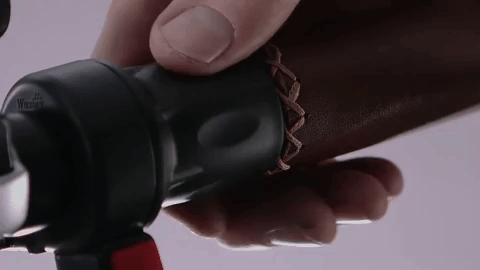
Source: Rad Power Bikes
All electric bike motors operate by pedaling or using the throttle.
You trigger the Pedal Assist System (PAS) by pedaling your e-bike. This process relies on the controller to give instructions to the motor, so it supplies an appropriate amount of power. The controller determines how much power to provide by interpreting information received from either a cadence sensor, torque sensor, or both. In addition, it considers the pedal-assist mode you choose (Eco, Turbo, etc.).
Conversely, the throttle operates independently of the sensors. By pushing/twisting the throttle, you activate the motor and transfer power up to a max speed. Although most e-bikes don’t have a throttle as they aren’t legal in Europe, an e-bike with a throttle is immediately considered Class 2 or 3 in the U.S. Find out more about e-bike classes below.
Types of Electric Bike Motors
As we’ll see throughout this article, there are three common electric bike motor designs, each of which has different characteristics. Electric bike wheel motors include direct-drive hubs and geared hubs. The other popular design is the mid-drive motor.
Mid-Drive Motors
Mid-drive electric bike motors take the name from their position on the bike. They sit in the middle of the frame, right between the cranks where the bottom bracket would be.
Mid-Drive Electric Bike Selection: 12 Models to Consider in 2025
This positioning creates a direct connection between the drivetrain and the motor, contributing to natural and smooth power output. However, it is essential to use the correct gearing to achieve this smooth efficiency.
- Most efficient
- Better handling due to the weight being low and central
- Less jerky acceleration means smoother power output
- Better traction control
- Easy to perform roadside maintenance
- More expensive
- Harder to maintain and repair
- Faster drivetrain wear
- Limited compatibility with front derailleurs
- The bike won’t work if the chain breaks
Direct-Drive Hub Motors
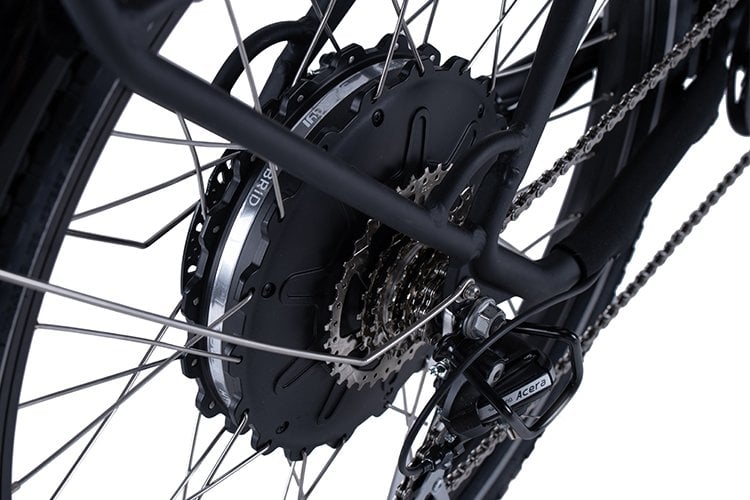
Image source: Rad Power Bikes
Direct-drive or gearless motors are the simplest and cheapest but are becoming obsolete due to their limitations.
The shaft is the wheel’s axle on a gearless motor, which drives the wheel directly. These motors don’t use internal gears, restricting the speed the shaft can turn (rpm) to how fast the wheel can turn. This limitation means direct drives have low torque levels.
- Cheap
- Quiet
- Durable
- High max sustained power
- Large
- Heavy
- Poor acceleration
- Inefficient
- Slight drag when pedaling
- Uneven weight distribution may negatively affect the handling
Geared Hub Motors
Geared hub motors work similarly to their gearless counterparts, except with a gear system within the motor shell. Instead of driving the axle directly, a geared hub motor’s shaft drives its gears. As a result, the shaft can turn faster, generating more torque but a lower max sustained power (and speed).
- Cheap
- Good torque levels
- No drag
- Smaller and lighter than gearless
- Low max sustained power
- Weight distribution may negatively affect the handling
- High torque in one wheel reduces traction control
- Noisy
Part of a Bigger Puzzle
Electric bikes require several electronic components to function, not just the motor and battery.
Battery
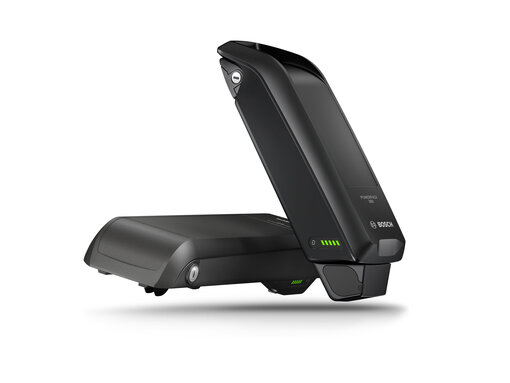
An e-bike battery is a very critical component that varies hugely between bikes. A battery’s main job is to supply power to the motor; additionally, they help determine the max range and influence handling, total weight, and frame design.
Sensors
Electric bikes rely on sensors to determine the amount of power the motor must supply at any given instant.
- Torque sensors – Mid-drive e-bikes use torque or a combination of torque and cadence to determine pedal assistance levels. Torque sensors are associated with a precise and natural power flow from the motor, delivering a ride-feel analogous to regular riding—harder pedaling = more power.
- Speed (cadence) sensors – These sensors monitor your pedaling speed to determine how much power is needed. Cheaper hub-drive motors typically use cadence. These sensors result in respectable power output, although they can feel clunky when climbing steep hills or riding technical trails—faster pedaling = more power.
Display
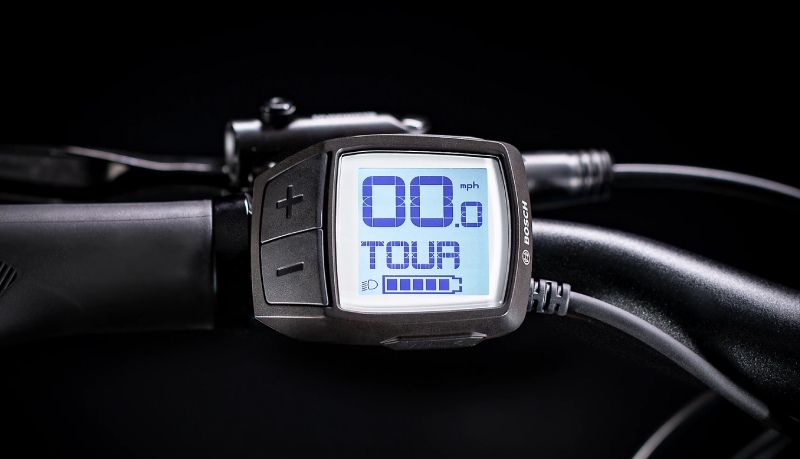
Image source: Trek Bikes
Almost all e-bikes have a display screen: basic or high-tech. For example, a basic model may only show pedal assistance and battery level. In contrast, high-end displays are comparable to fully-equipped bike computers with all possible ride metrics and a range of settings and connectivity options.
Depending on the bike, you change the PAS level through the display or with buttons elsewhere on the handlebars.
Controller
An e-bike controller is the brain of the whole system. It is a mini-computer that connects to all of the other electronic components.
The battery, motor, and controller of an e-bike system must match to function correctly.
Its job is to take inputs from the motor, battery, sensors, and display. Then, it processes these inputs and gives instructions or information in return. Some of the controller’s jobs include:
- Use sensors to determine how much pedal assistance is required
- Regulate voltage from the battery (high or low voltage can damage the motor)
- Cut power to the motor when braking
- Shut the motor off if it’s too hot
- Communicate battery level and pedal assistance level to the display
How Much Power Do You Really Need?
What Do Motor Ratings Mean
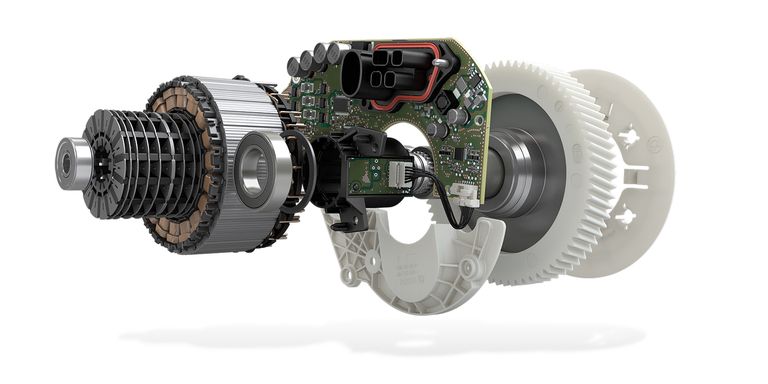
Image courtesy: Bosch
There are no standard measurement criteria for rating motor power or torque. This fault in the industry creates a lot of confusion and frustration for e-bike owners (and reviewers), as one manufacturer’s rating may be completely different from the next.
The way to determine the true power output of a motor involves calculating:
- How heavy is the load on the motor?
- What are the specific operating circumstances?
- What’s the max amount of power the controller lets flow to the motor?
We can only determine precisely how an e-bike motor will perform in a given situation with these parameters defined.
A test ride of the e-bike you plan on buying is the best way to get an accurate feel of what it is like to ride it.
Otherwise, brands like Bosch and Yamaha provide a percentage rating for each motor, quantifying the maximum amount of support it delivers. This rating gives a better idea of how powerful a motor is.
Torque Ratings
Torque ratings give another clue about power and how a bike will accelerate and perform on climbs. But, again, you shouldn’t base your purchase on the torque rating.
Torque and rpm are required to define power, and while torque isn’t too complex to determine, it’s challenging to define a motor’s rpm, which makes the measurement less helpful.
Power Ratings
As described above, power output relies on a defined torque (Nm) and speed (rpm) in a given situation, making it difficult to quantify.
With that in mind, the one relevant power measurement should be sustained or continuous power. For example, a manufacturer can list the peak power as 750W if they have achieved that power for 2-3 seconds. Another brand may base it off the peak power achieved for 10 seconds without considering efficiency. Unfortunately, neither of these numbers tells you how much power the motor can sustain.
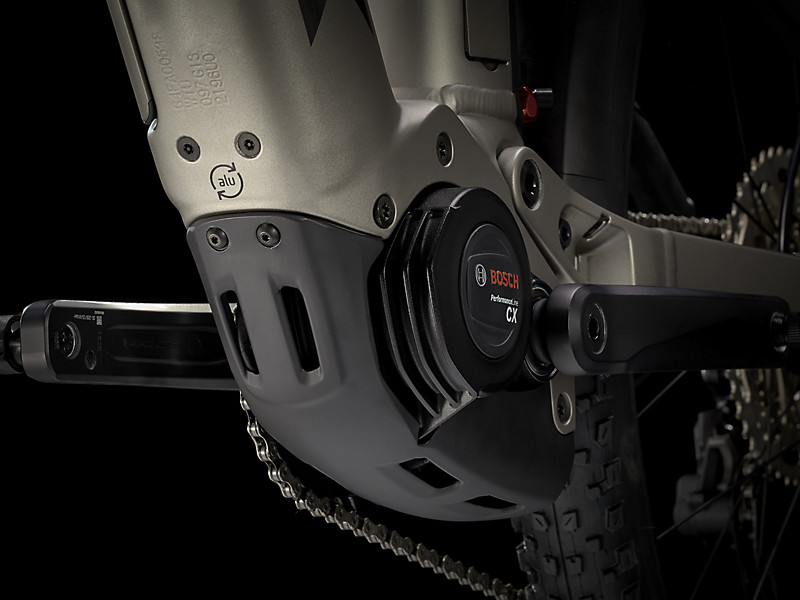
Image source: Trek Bikes
The best way to calculate an accurate power rating for a motor—without getting too scientific—is to multiply the battery’s Voltage rating with the controller’s Amp rating. Then, as e-bike motors aren’t 100% efficient, adjust the number to 75% of the total. Note that the best mid-drive electric bike motor is more efficient than 75%.
An example: 48 (V) x 20 (Amp) = 960W. 960 x 0.75(%) = 720W
Considering the above information on power ratings, we are now in a slightly better place to choose an e-bike motor. The most important lesson about motor ratings is to take them with a grain of salt when choosing an e-bike. Remember, electric bikes with mid-drive motors are more efficient than hub motors, meaning they generally achieve a higher percentage of the listed power rating.
Choosing a Power Rating
Assuming we know an accurate sustained power rating for specific motors, we can imagine their best applications.
- 250W Hub – These motors are great for day-to-day use on cheap, lightweight commuters, fitness, or folding e-bikes. Premium electric road bikes and gravel bikes also use Ebikemotion’s high-end X35+ hub-motor.
- 250W Mid – A popular choice for premium e-road or e-gravel bikes, like the Fazua Evation or Bosch Performance CX. These are light and don’t affect the handling, making them perfect for lightweight bikes and riders with reasonable fitness levels.
- 500W Hub – This is a typical motor for budget, entry-level, and mid-range electric mountain bikes and city bikes. Moderate power allows riders to carry cargo and tackle steeper gradients with lower fitness.
- 500W Mid– These are found on mid to high-level e-bikes and usually provide enough power and torque for any gradients regardless of fitness level. Models include the STEPS EP8 Shimano electric bike motor or Bafang’s M600.
- 750W Hub – A popular choice for low-cost, heavy e-bikes used to carry heavy cargo. Additionally, cheaper off-road hunting bikes use these motors because they are powerful, affordable, and work independently of the drivetrain.
- 750W+ Mid – Mainly used on premium off-road e-bikes that need tons of power for carrying full payloads and taking on extreme terrain. Bafang’s M-series has one 750W and 1000W, and Bosch has a 1250W motor for cargo e-bikes.
- 1000W+ Hub – An electric bike hub motor of 1000W or more is technically on par with a moped or scooter. These motors provide enough sustained power to do anything you could require of an e-bike. They are used predominantly on heavy off-roaders or moped-style e-bikes.
In addition, it’s possible to find a dual-motor electric bike with two 500W hub motors.
>>>Related: 250W Mid-Drive vs. 750w Hub E-Bike Motors
Electric Bike Classes
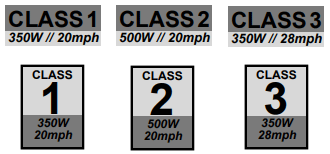
Electric bike classes help with the creation of e-bike regulations. Each class has a power limit and max speed; high-power, high-speed bikes are subject to stricter regulations.
There are three e-bike classes (Class 4 is for mopeds, scooters, or an electric bike motor with 1000w+).
- Class 1 – Includes e-bikes without a throttle and a 20mph max assisted speed
- Class 2 – Electric bikes with a throttle and a max speed of 20mph
- Class 3 – Max assisted speed of 28mph, with or without a throttle
- Class 4 – 1000W+ motor power and 28+ mph top speed. Not street legal in the USA.
In the United States, Class 1 and 2 e-bikes are generally not subject to additional regulations. However, Class 3 e-bikes are subject to restrictions in most states. These regulations vary, but examples include wearing a helmet or prohibitions for riding in national parks. For a state-by-state breakdown of the laws, check out PeopleForBikes.org.
Hub Motors vs. Mid-Drive Motors
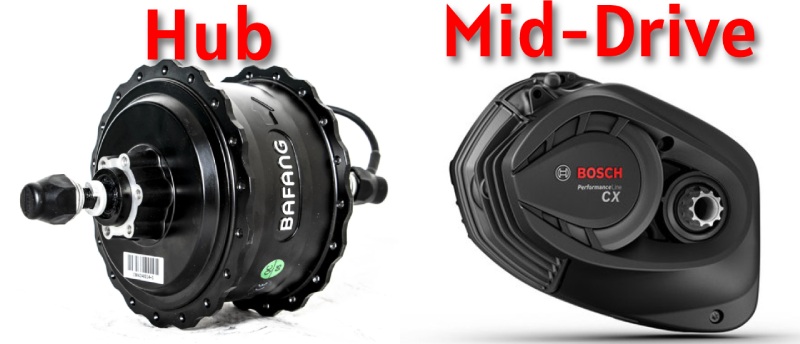
One of the first questions new e-bikers ask is, “Should I buy a mid-drive or wheel hub motor for an electric bike?”. The main factors to consider are:
- Where you plan on riding (gradients, terrain)
- Budget
- Type of bike
- Payload (cargo, bike weight, and rider weight)
In general, mid-drives are better for climbing steep gradients and hauling heavy cargo. Additionally, they are more efficient, which may help extend battery life, provide better traction, and are more responsive. These attributes make them the best electric mountain bike motor.
Another advantage is the torque-sensing that contributes to a more natural ride feel.
The issue with mid-drives is that they cause faster drivetrain wear, increasing maintenance costs, and they are more expensive than hub motors up front.
On the other hand, hub motors are usually cheaper and easier to maintain, but they are slightly less efficient and aren’t as smooth. Nevertheless, these factors are subtle enough that many riders won’t notice. The differences become noticeable in extreme use cases, like climbing super steep gradients and riding technical trails.
Regardless, hub motors are adequate for many riders, and they help keep the budget down. The most noticeable difference may be the effect on handling from the added weight in the wheel.
Geared vs. Direct-Drive Hub Motors
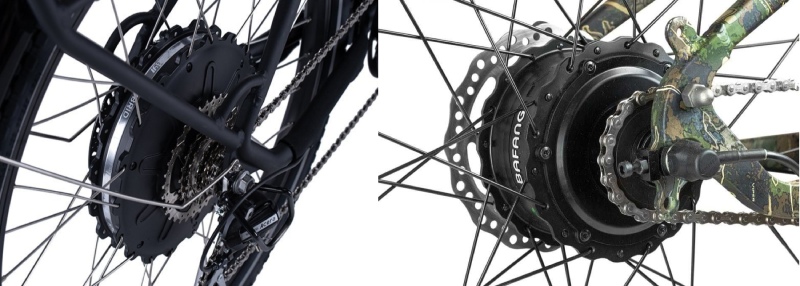
Direct-drive vs. geared hub motor. Which one is better?
Choosing between a direct-drive and geared hub motor is less complex and typically comes down to determining if you want a higher max sustained power or a smaller, lighter, and more efficient system.
As geared hubs are more efficient and lighter, they achieve higher ranges than gearless alternatives. In addition, there is no drag created when freewheeling. If super high max power isn’t required, these motors are superior. The one caveat is the extra noise from the gears and the slightly lower durability from the added mechanical complexity.
The situation where direct-drive motors excel is at sustaining high max speeds. In addition, they are more durable and quieter. These attributes may appeal to some riders but don’t provide enough advantage over a geared motor.
Popular E-Bike Motor Manufacturers
In recent years, the soaring popularity of electric bikes has resulted in healthy competition between motor manufacturers, driving innovation forward. As a result, motors are becoming more efficient, smaller, lighter, powerful with each passing year. Here are some of the most prominent manufacturers today.
Shimano
Shimano is undoubtedly the most prominent producer of bicycle components in the world. Their STEPS e-bike motors are some of the best on the market, used by over 160 brands.
There are six different motors in the STEPS range:
- E500/E600/E6100 – Three city/trekking motors used by Kona, Trek, Gazelle, Blix Bikes
- E700/E800/EP8 – Three e-MTB models used by BMC, Orbea, Norco, Pedego, Devinci
Bosch
Bosch electric bike systems are another favorite choice for e-bike manufacturers. They only develop mid-drive motors or “drive units“ for electric city, MTB, hybrid, and cargo bikes. Their systems provide incredibly smooth power transfer thanks to pedal power, cadence, and speed sensors measuring over 1,000 times per second.
Brands that choose Bosch Performance Line systems include Ghost, Cannondale, Trek, Niner, and Cube. Additionally, Canyon, Electra, Haibike, and Priority Bicycles use the Active Line and Cargo Line motors. Therefore, it’s easy to find an electric mountain bike with a Bosch motor (usually the Performance Line) or a ladies electric bike with a Bosch motor.
- Active Line
- Active Line Plus
- Performance Line
- Performance Line CX
- Cargo Line
Brose
Another high-end manufacturer of e-bike motors is Germany’s Brose, used by over 50 manufacturers worldwide. Their range consists of four different models for three bicycle styles; eCity, eTrekking, and eMountain. In addition, you can find Brose systems on popular brands like Specialized, BH, and Rockrider.
Each of the four motors comes in either a magnesium or aluminum shell. The aluminum drives allow manufacturers complete flexibility when integrating the motor into the frame. However, the magnesium-shell versions are 500g lighter and 15% smaller.
Here’s how they categorize their motors:
- Drive C – City Champion
- Drive T – Long-distance Runners
- Drive TF – Sprinters
- Drive S – Summiteers
Fazua

Image source: Fazua
Fazua, and specifically their Evation motor, is one of the most popular brands in the e-bike motor industry. The biggest names in cycling use their motors, including Canyon, Pinarello, Trek, Wilier, and Fuji.
All Fazua motors are mid-drives, and the systems are exceptionally lightweight and efficient.
- Ride 50 Evation – Found on eRoad, and eGravel
- Ride 50 Trail – eMTBs
- Ride 50 Street – eCity or urban e-bikes
They are generally found on mid-to-high-end electric bikes with the smoothest, most natural ride qualities.
Mahle Ebikemotion
Ebikemotion Technologies is a specialist subsidiary of German automotive brand Mahle. Ebikemotion’s only motor, the X35, is renowned for its lightweight design (the whole system weighs 7.7lbs) and natural feel despite being a hub motor. It’s most commonly used for electric road bikes and a few XC, Gravel, and Urban models.
The world’s best bike brands such as Cannondale, Colnago, Bianchi, Pinarello, Orbea, and Wilier use the X35 motor. That’s because its design allows enormous flexibility to manufacturers during frame design. Additionally, the low weight and lack of friction when the electronics are off mean your electric road or gravel bike will feel exactly like a standard lightweight bike.
Yamaha

Image source: Yamaha
The famous motorcycle brand Yamaha offers five excellent mid-drive units recognized for their ultra-fast motor response:
- PW Series (CE/TE/ST) – This is an urban and commuter motor choice for everyday riders, found on electric hybrid bikes and city bikes that are best for less aggressive riding
- PW-X2 – Fast, smooth, and natural power output intended for more aggressive riding on eMTB or eRoad bikes
- PW-X3 – The same motor as the PW-X2 but lighter and smaller with even more power. Typically used as an electric motor for a mountain bike
Some brands that use Yahama systems include Haibike, Ghost, and LaPierre. In addition, they developed Giant’s SyncDrive mid-drive motor used across their e-bike range.
Electric Bike Motor Kits
If you don’t fancy the cost of purchasing a new e-bike, there is another route to go. You can add an electric motor to a bike with an electric bike motor kit.
These kits come with all components necessary for conversion, including motor, controller, sensors, display, cables, mounting equipment, and brake levers. Further, you can purchase different options, such as an electric bike motor kit with a battery or a mid-drive or hub motor option.
Let’s look at the pros and cons of using a conversion kit.
- Generally cheaper than buying a new e-bike
- Allows you to choose the exact specifications you want (power, battery size)
- You can swap the kit between bikes
- Requires some installation knowledge or paying a professional
- Looks messy as all the parts and cables are externally mounted
- Negatively impacts the handling as standard bikes aren’t designed to have the extra weight added
- May require additional purchases such as better brakes or different tires
- Not as safe or effective as a factory-made electric bike
- No warranty
With all things considered, the negatives seem to outweigh the positives, especially with the low price of factory e-bikes. However, using an e-bike conversion kit might still appeal to some riders.
FAQ
 Is an electric bike a motor vehicle?
Is an electric bike a motor vehicle?
No, an electric bike is not a motor vehicle. Electric bikes have their own classification, which includes three classes based on the max-assisted speed and whether or not the bike has a throttle. An e-bike with a max speed of over 28mph is considered a motor vehicle.
Are electric bikes considered motorized?
Yes, electric bikes are considered motorized as a motor moves them. However, limitations to max speed mean they are not in the same category as motor vehicles. In addition, many electric bikes cannot operate without the rider pedaling to activate the motor.
How long does an electric bike motor last?
Electric bike motors last 10,000 miles on average. Factors such as usage, storage, and care will impact the lifespan of a motor. The different types (direct-drive, geared hub, mid-drive) have slightly different wear rates, and hub motors are easier to maintain.
How do electric motor bikes work?
Electric motor bikes work by turning electrical energy into mechanical energy (movement). The mini-computer system (controller) directs a specific amount of energy (stored in the battery) to flow to the motor, which in turn spins to turn the motor shaft at the wheel hub or the cranks.
How to make an electric motor bike at home?
You can make an electric motor bike at home using an e-bike conversion kit. Popular kits like Bafang or Bosch electric bike motor kits can be purchased online and installed by a professional or a competent home mechanic. Ensure the one you choose has a battery included.
Which motor is best for electric bikes?
The best motor for electric bikes depends on the rider’s preferences, budget, and the style of the specific bicycle. For example, one rider may have a low budget and high demands. In this case, a cheap electric hub motor fat bike helps keep costs down and allows aggressive riding.

